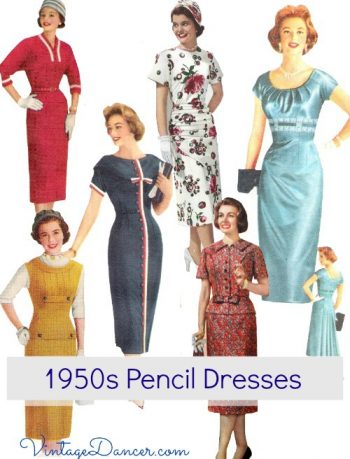
1950s pencil dresses
When you think of dresses in the 1950s, what do you imagine? Most people would think of the classic housewife dress that Lucile Ball or Mary Tyler Moore wore in their respective 1950s TV roles, with their large puffy skirts and snug fitting blouses, paired with cute coordinating accessories and perfectly groomed hair. While this style of dress was certainly popular, there is another style, the opposite look of the 1950s, that had been overlooked until now. Because of TV shows like Mad Men and Pan Am, the slim fitting 1950s pencil dress — also known as wiggle dress or sheath dress — is just as popular as its full-figured sibling.
Scroll down to shop pencil and wiggle dresses.
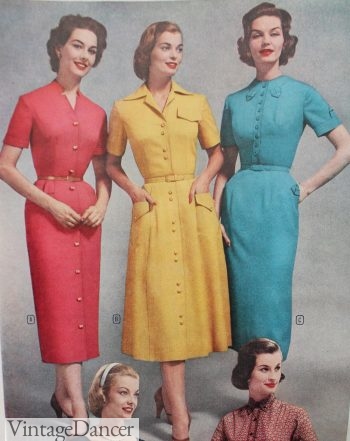
1957, full and pencil house dresses
This other silhouette of the ‘50s was somewhat opposite of the full skirted look, although the main features of the New Look remained. The bodice was the same – tailored, fitted and nipped in at the waist. But the skirt of this type of dress was very closely fitted to the body from the waist down. This was the lean sheath dress. Today, it is known as a 1950s pencil dress or wiggle dress. The pin up fashion movement has also claimed the wiggle dress as one their own.
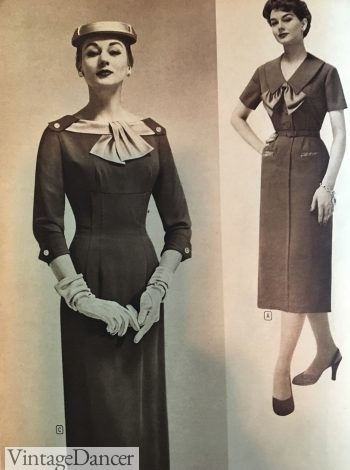
50s Pencil dress with bow collar
The pencil dress bodice was usually tailored and if it wasn’t sleeveless, it had short or elbow-length sleeves. The neckline was often a scoop or boat-neck. The skirt was what we’d call a pencil today: it curved over the hips and tapered down to mid-calf. There was a vent or kick-pleat added to the back of the skirt so the wearer was able to walk – that’s how fitted they were! 50s wiggle dresses zipped up the back, and the bodices were often decorated with small collars and bows. The skirts often featured welt pockets on the sides or two oversized front patch pockets. Big buttons could be used to decorate the front.
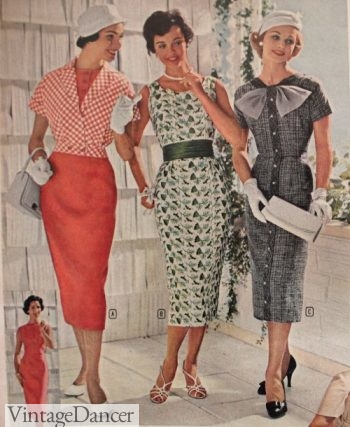
1958 pencil dresses or wiggle dresses
1950s Bell Shape Dress
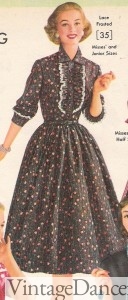
Late 50’s Bell Shape Dress
A trend that emerged towards the end of the decade was the bell dress – a kind of combination of the two skirt shapes. The bodice was tailored and fitted as usual and could follow any of the bodice styles found in dresses. However, the skirt started out gathered at the waist, puffed out around the waist, and then tapered back in to be fitted at the calf, creating a bell shape. It was often tied in front with a large fabric bow. By the late ’50s, the shape of the bell tapered out only slightly, creating a skirt that was full, but not nearly as wide as circle skirt dresses.
1950s Corolla, Tulip, H, A and Y Lines
Dior, and many other fashion designers started coming out with a new silhouette every season. Although they didn’t stray far from the New Look hourglass silhouette, they offered a slightly different shape each time – enough so that women were pressured to keep up. Although most women stuck with the basic full or fitted hourglass, the most fashionable would have a slightly different one to show off each year. Dior’s most well known collections were the Corolla (his debut) in 1947, the Tulip in 1953, and the H-, A- and Y- lines of 1954-56.
The Corolla was the basis for the New Look and was the main silhouette of the ‘50s. The Tulip look was a little bit more exaggerated. A Tulip dress was fitted. The bodice had a large boat-neck collar that emphasized the bust, the requisite tiny waist, and a very round hip bound inside a fitted pencil skirt.
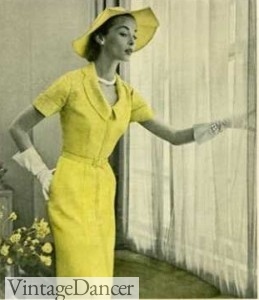
Tulip Sheath dress
A H-line dress was a little bit different. It was a fitted sheath again, but had a higher scoop neck and a dropped waist. The natural waist was still fitted and small, but the waist emphasized on the dress was much lower, making the silhouette straighter.
The A-line dress was very different – the bodice was very narrow, but the dress was shaped just like an A with a full pleated skirt and undefined waist.
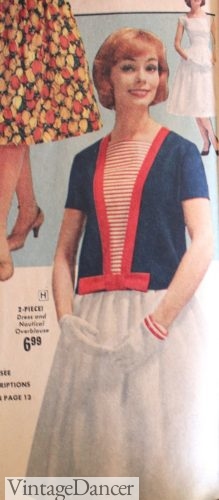
A-line Dress, 1953.
The Y-line went back to the classic Dior silhouette with a fitted sheath, an added large pointed collar, and sleeves.
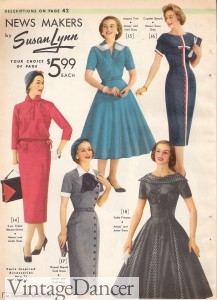
1957 Dresses
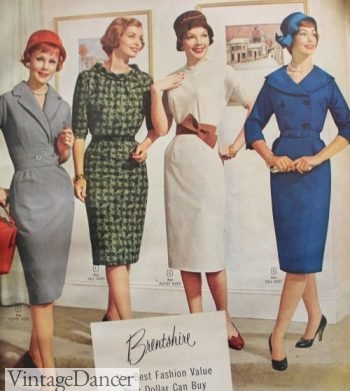
1959 sheath dresses
Now that you know a little bit about the different variations of 1950s sheath dresses, you won’t be able to look at a pencil or wiggle dress quite the same. I enjoy seeing the details on dresses in the 1950s and guessing what Dior line inspired the design. It’s a little game to make your next vintage ’50s shopping trip a little more fun.
Shop 1950s pencil dresses
Debbie Sessions has been teaching fashion history and helping people dress for vintage themed events since 2009. She has turned a hobby into VintageDancer.com with hundreds of well researched articles and hand picked links to vintage inspired clothing online. She aims to make dressing accurately (or not) an affordable option for all. Oh, and she dances too.